Every once in awhile I like to take a walk down memory lane and highlight an old-school entrepreneur who isn’t typically talked about nowadays.

Why?
Because people today are soft and we’ve completely lost our grit. I don’t think that people nowadays are inherently weak, it’s just that modern life is so much easier than say, the late 1800s when American capitalism was in its prime.
And so, here is part 1 of The Epic Rise, a series on America’s grittiest, toughest business people.
Part 1 is on John David Rockefeller, the founder of Standard Oil and the richest person to ever live, not just in America, but in the history of the world. Although Standard Oil was eventually forced to break into multiple companies because it was ruled a monopoly, BP, Exxon, ConocoPhillips and Chevron (among others) are all subsidiaries of Standard Oil.
NOTE: Want more? Read Titan, John D’s bio. It’s a ten of out ten.
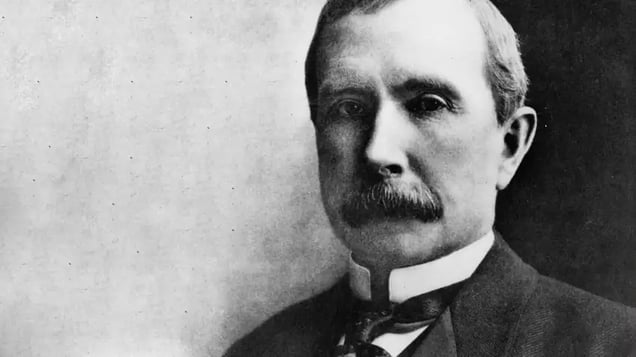
Rockefeller was completely self-made and had a combination of ruthless business tactics, strategic brilliance, and a passion for philanthropy, making him a complex individual that any wannabe business person can learn from.
John Davidson Rockefeller was born on July 8, 1839 in Richford, NY to Eliza Rockefellar, a homemaker, and William Rockefeller, a con artist.

Known later in life as John D., Rockefeller was born into a poor family.
Rockefeller’s father, William, was a traveling salesman and self-described “botanic physician” who refused to live a normal 9-to-5 life.
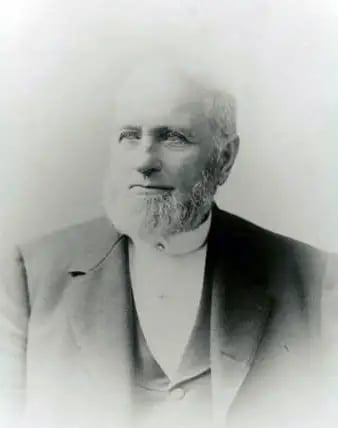
Devil Bill, John’s father.
Known as Devil Bill, William was famous for traveling from town to town selling homeopathic medicine that “cured cancer” and other shady schemes. He had girlfriends in each city and even had children with a few of them, a fact that John tried to hide his entire life.
When John was a child, William admitted to tricking him in hopes of making his son a tough businessman. “I do business deals with my sons and I always try to cheat them to make them sharp,” Bill once told his neighbors. This upbringing set the stage for John’s cunning business tactics.
Because her husband was always on the road, Eliza Rockefeller didn’t have much income, so she taught her children how to be thrifty.
“Willful waste makes woeful want,” Eliza used to tell her children. While Rockefeller’s father taught him dishonesty and ruthlessness in order to get ahead, Eliza instilled in John the sober habits of her Christian faith: thriftiness, hard work, and self control. Starting at a young age, Rockefeller earned money from his neighbors by raising turkeys and selling pieces of chocolate to his school mates.
By the time Rockefeller was 12 he had saved $50, about $1,400 in today’s money. Following his mother’s advice, he loaned his $50 to a local farmer at 7% interest, payable after one year.
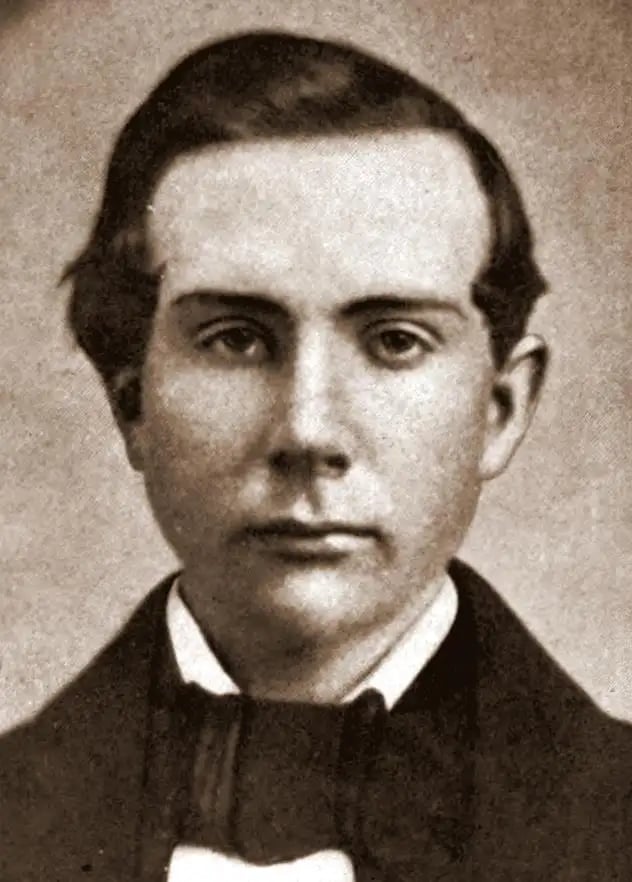
An earnest young John D.
It was around this time that Rockefeller learned the power of interest. “The impression was gaining ground with me that it was a good thing to let the money be my servant and not make myself a slave to the money,” he said of this time. As a kid, Rockefeller was known for being particularly serious and rarely smiled.
In 1855, when he was 14, John and his family moved to Cleveland, OH.
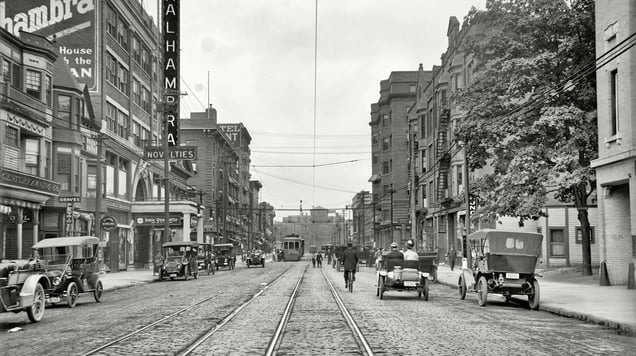
A bustlin’ photo of Cleveland in the 1800s.
John’s father was involved in a rape scandal and several scams, which prompted Eliza to move the family to hide from the embarrassment. She chose Cleveland. Because of the recent railroad construction, Cleveland was a booming city with a focus on the manufacturing and garment industries. However, its biggest draw was oil. At one point, Ohio had one of the largest known oil reserves in the world.
To help pay the bills, a 16-year-old Rockefeller landed his first job as an assistant bookkeeper with Hewitt & Tuttle, a produce brokerage.
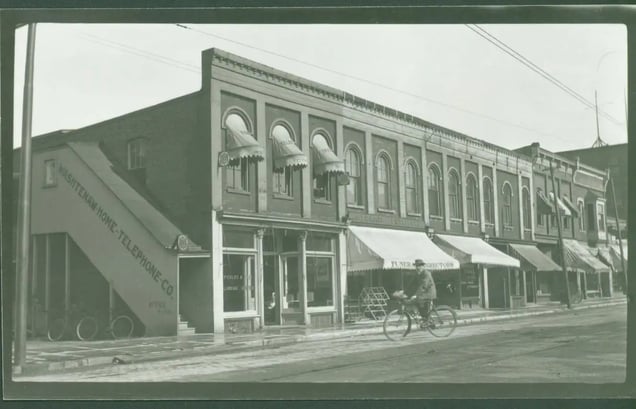
The tall building in the middle right background was the second-floor Hewitt & Tuttle.
Because he had experience giving out loans and selling small items, Rockefeller was a skilled bookkeeper at a young age. To find a job, he went door to door for months, presenting a plan to business owners on how his book keeping services would save them money. On September 26, 1855, after months of searching, he signed on as a bookkeeper, making 50 cents a day at a produce brokerage firm called Hewitt & Tuttle.
Until the day he died, Rockefeller celebrated “job day” every September 26 to commemorate his entrance into the business world. “All my future seemed to hinge on that day,” he reminisced later in life. “I often tremble when I ask myself the question: ‘What if I had not got the job?’.”
To live frugally while he was a young professional, Rockefeller kept a journal of all his expenses, which he called Ledger A. He kept the habit of writing out all his expenses until the day he died.
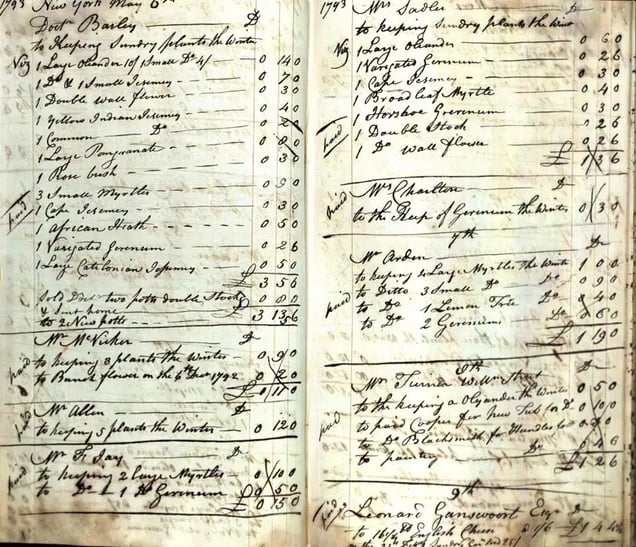
He closely reviewed every bill and jumped on errors of even a few pennies. Rockefeller was amazed at the laxity and inefficiency of his much older peers, which distinguished him from an early age. This thorough, systematic way that he did things was more recognized at this time than his brilliant, flashing intelligence. Even as a wealthy man, Rockefeller was known to go to extreme measures to pay back pennies that he owed.
Years later, when asked about his first ledger, Rockefeller said he wouldn’t try all his riches in the world if it meant giving up his ledger.
“I was trained in business affairs, and I was taught how to keep a ledger,” he said. “The practice of keeping a little personal ledger by young men just starting in business and earning money and requiring to learn its value is, I think, a good one. It is more than forty-two years since I wrote what it contains. I call it Ledger A, and now I place the greatest value upon it.”
It was around this time that Rockefeller started giving away 10% of his earnings to charity, another habit he started when he was young and practiced until he died.
At 18, after getting into an argument with his boss about his low pay, Rockefeller used two years of savings to open his own produce brokerage firm.

To start the business, Rockefeller and his partner used savings, borrowed money from Devil Bill, and got a bank loan to pool together $4,000, about $100,000 in today’s money. The firm sold practically everything that passed through Cleveland including pork, grain, and other commodities. “Think of it, a bank had trusted me for $2,000!” Rockefeller said of the time. “I felt that I was now a man of importance in the community.”
The produce business took off immediately, making young John Rockefeller a popular Cleveland businessman at the age of 21.
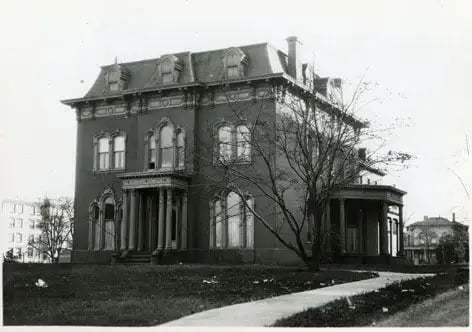
Rockefeller’s (relatively) modest Cleveland home.
“Business came in upon us so fast that we hardly knew how to take care of it, and in the first year our sales amounted to half a million dollars,” Rockefeller said. During this time, Rockefeller’s famous work ethic came to be. He arrived at the office with clocklike precision at the same time every morning, went home for dinner with his family, and would often return to the office at night.
In 1859, when Rockefeller was only a few years into his first company, America drilled their first oil line in nearby Pennsylvania, starting the black gold craze.
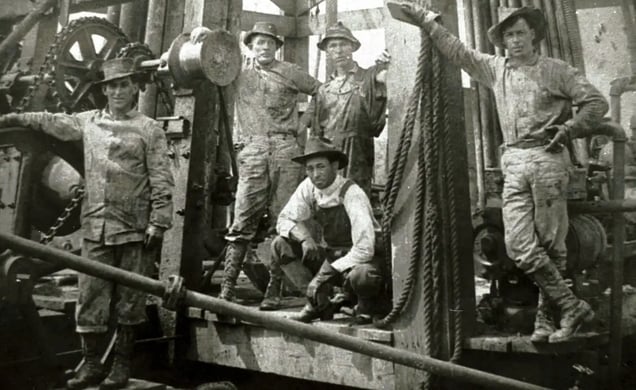
Wildcatters.
Men came from every part of America to get their fill.
In 1863, sensing an opportunity, Rockefeller and his business partner teamed up with a chemist to start a refinery.

Standard Oil’s humble beginning.
Unlike most oil men, Rockefeller was no wildcatter. He believed drilling for oil was a very risky business. Refining, not drilling, he decided, was where the steady money was.
Soon, a new rail line linked Cleveland with the oil region. Rockefeller built his refinery right beside it. It was one of the first in the city to produce kerosene, the new fuel for lamps that was cheap and clean. “The poor man’s light,” as John D. called it, would bring a brilliant glow into American homes. The soaring demand for it, he was convinced, would make him rich.
“I shall never forget how hungry I was in those days,” he later wrote. “I ran up and down the tops of freight cars … I hurried up the boys.” Obsessed with the business of oil, he mastered every detail, developed new products to sell, even using the waste to create products like petroleum jelly (aka Vaseline).
After a year, Rockefeller and his partners had an argument about the future of the business, so they decided to part ways. Following a bidding war, 31-year-old Rockefeller paid $72,500 to purchase the refinery.
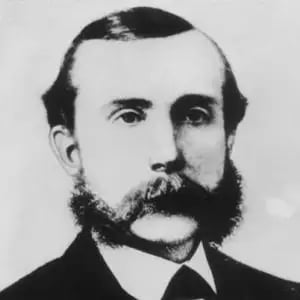
John D. once had a handlebar mustache that would give Yosemite Sam a run for his money. Unfortunately, this stage of his life didn’t last long.
Rockefeller said, “it was the day that determined my career.” To afford the bid, which cost well over a million dollars in today’s terms, Rockefeller borrowed heavily from banks, putting himself deep into debt.
During this time, he wrote that he could barely sleep at night because of the anxiety that he might fail. “All the fortune that I have made has not served to compensate me for the anxiety of that period,” he said.
The new venture was called Standard Oil.
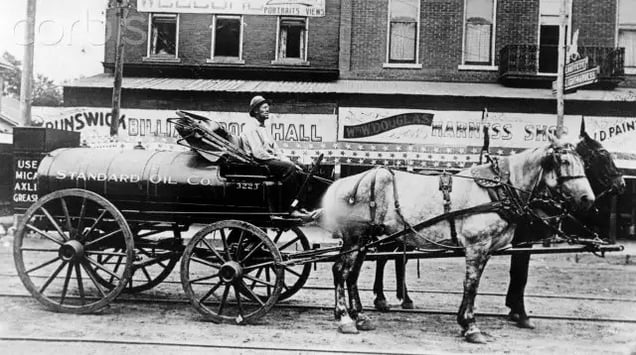
An early Standard Oil wagon, used to deliver kerosene.
Standard Oil’s first physical plant was simple: some large vats, stills, piping, and a few chemicals. A small refinery could be set up back then for just $10,000, and a large one for $50,000. In other words the barriers to entry were very, very low. Because of this, Rockefeller realized early on that in order to make oil a profitable business, he needed to build a massive operation and take advantage of economy of scale.
To grow the business, Rockefeller took an approach similar to other business magnets at the time: remove competitors at all costs.
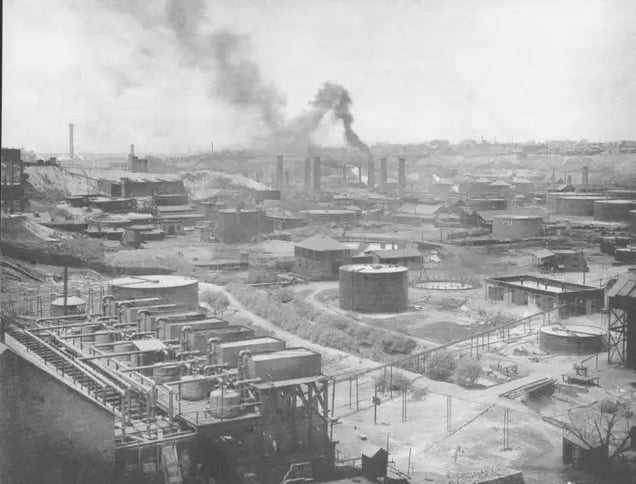
Standard Oil’s early refinery.
By 1872, only a few years into business, Rockefeller used a series of acquisitions to become the largest refinery in the world. When asked about why he was so driven to grow the company so fast, Rockefeller said: “Having being endowed with the gift I possess, I believe it’s my duty to make money and to use the money I make for the good,” he said.
To continue growing, he went on a buying spree, buying two dozen refineries in 60 days. To finance the everything he reinvested the profits and begged banks for more money. Before this series of acquisitions, few businessmen understood how monopolies worked. Rockefeller was the first to focus on aggressive growth by buying smaller companies, a move that pioneered modern American capitalism.
By 1882, Standard Oil controlled over 90% of America’s refineries.
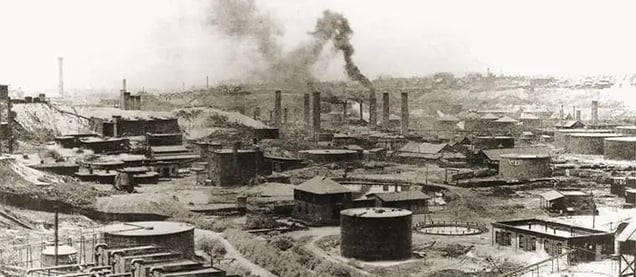
It was around this time that critics began calling out Rockefeller for his ruthless business tactics, which centered around eliminating competition.
According to Rockefeller, he felt it was his job to control the entire oil industry in order to to fulfill his mission: create a way for everyone in the world to afford kerosene, and make massive amounts of wealth in order to give it away. “Competition is sin,” he once said.
To further his mission, Standard Oil made ruthless deals with the railroads.
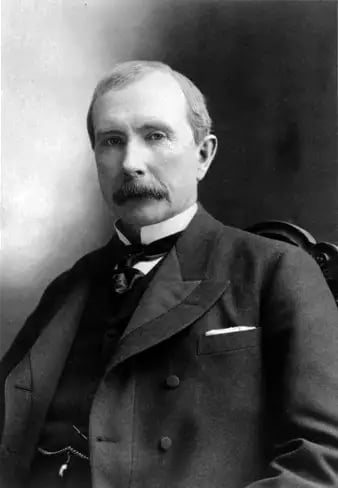
John D.
At the time, the major factor preventing oil companies from rapidly expanding was the high cost of railroad transportation. To combat this, Rockefeller made a secret deal with the largest railroad companies, promising massive bulk shipments in exchange for prices that drastically undercut his competitors and ultimately destroyed them. This secret deal was the reason why congress later labeled Standard Oil a monopoly.
During this time, Rockefeller and the railroads made deals through handshakes, not written contracts, as they knew if their deals were discovered they’d be brought down.
By 1865, Standard Oil was the largest and most profitable organization in the world, moving to Manhattan to house all the new employees.
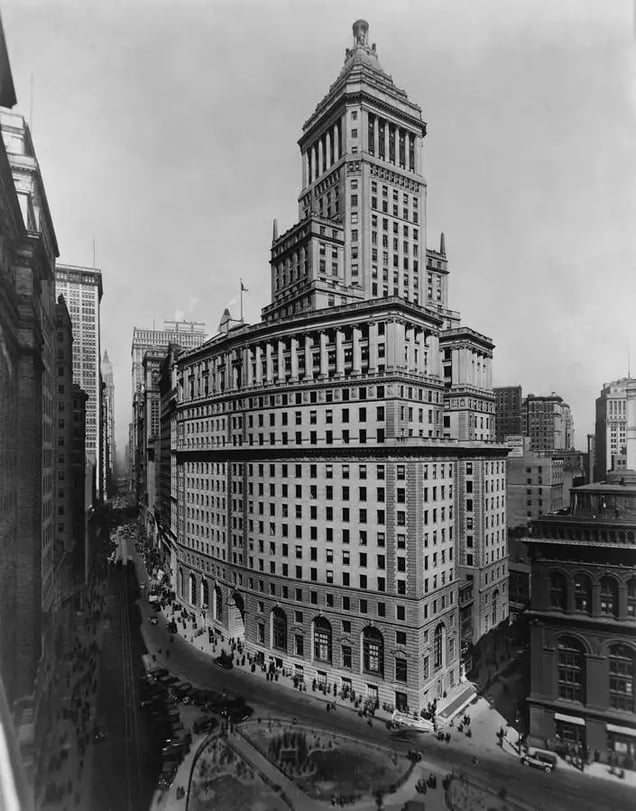
26 Broadway.
This building still stands today right in the middle of Wall Street.
By this point, Standard Oil was called “the most cruel, impudent, pitiless, and grasping monopoly that ever fastened upon a country” by America’s largest newspaper. Standard Oil was infamous for underselling kerosene to put local competitors out of business, similar to how Walmart behaved in the 1990s.
Standard Oil’s vast empire included 20,000 domestic wells, 4,000 miles of pipeline, 5,000 tank cars, and over 100,000 employees.
In 1902, Ida Tarbell, the daughter of an oil refiner from Ohio who went out of business because of Standard, wrote a series of articles on Rockefeller’s famous deal with the railroads called ‘The History of Standard Oil’.
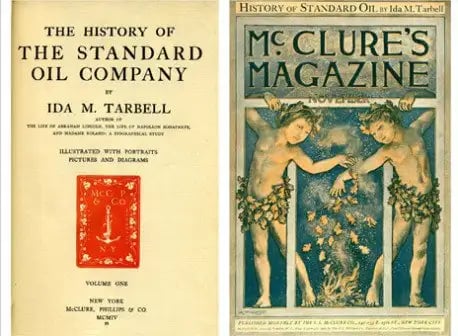
Ida Tarbell’s articles later became a book.
The article later turned into a book, bent on proving how arrogant Standard Oil was and making Rockefeller America’s biggest enemy.
The most painful blow, however, was Tarbell’s exposure of Rockefeller’s father as a snake-oil salesman, bigamist, and accused rapist, a fact that Rockefeller hid nearly his entire life. The discovery that Devil Bill was still alive set off a nationwide manhunt. One newspaper offered $8,000 for information about him. Rockefeller began to fear that his children might be kidnapped and secluded himself from the public.
Labor activists, politicians, and demonstrators now hated Rockefeller. People even tried to kill him. And then it got worse.
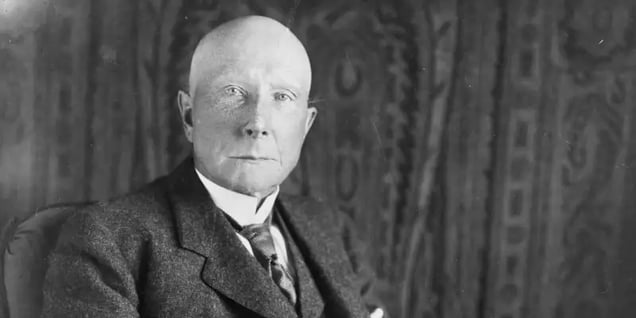
A hairless John Rockefeller.
Only in his 50s, the stress and overwork caused Rockefeller to have a nervous breakdown. He lost all of his hair, including his eyebrows. And because he was famously media shy, Rockefeller refused to address his critics, making them hate him even more.
In 1904, President Theodore Roosevelt, an opponent of monopolies, vowed to destroy Standard Oil.

Teddy R. and his cabinet.
The federal government filed a massive anti-trust suit against Standard, the first of its kind.
During the suit, Rockefeller’s health worsened and he refused to give interviews. He retreated to a country home on the outskirts of New York. To distract himself from the stress, Rockefeller decided to devote his time to giving away his wealth. By this point (still in his 50s) he was the richest person in the world by a huge margin.
Rockefeller gave to schools, starting the University of Chicago and Spelman College, a free university for young African-American women. However, the media still viewed him as a stingy monster.
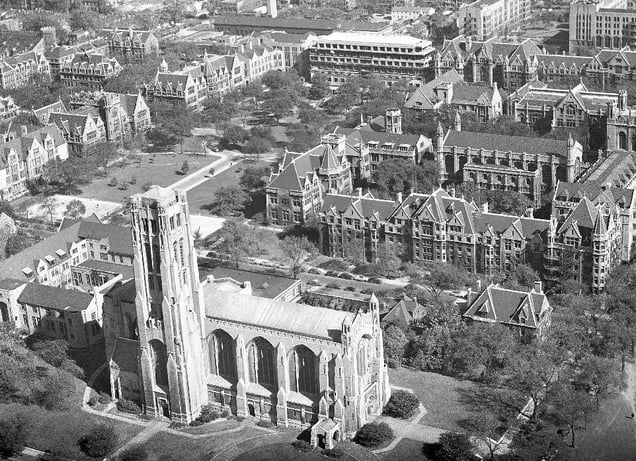
University of Chicago.
In line with his modest Baptist demeanor, Rockefeller refused to make his donations public, even though he was vilified in the media for being stingy and ruthless. To this day, there is little evidence on the University of Chicago campus that it has anything to do with Rockefeller.
In addition to founding and supporting multiple schools, Rockefeller is attributed with having started the first ever research hospital, which resulted in eradicating hookworm and yellow fever.
By 1912, Rockefeller had given away hundreds of millions of dollars (billions in today’s terms). Rockefeller’s fortune peaked in 1912 at almost $900,000,000, but his estate totaled only $26,410,837 when he died, making him the biggest philanthropist ever to live.
While his accomplishments and wealth are unparalleled, it was Rockefeller’s complex personality that made him one of history’s most badass entrepreneurs.
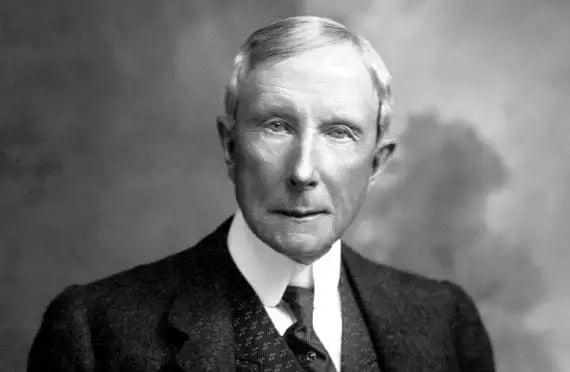
Rockefeller in his 50s.
His combination of discipline, ruthlessness, and generosity made him difficult to understand.
He was ruthless.
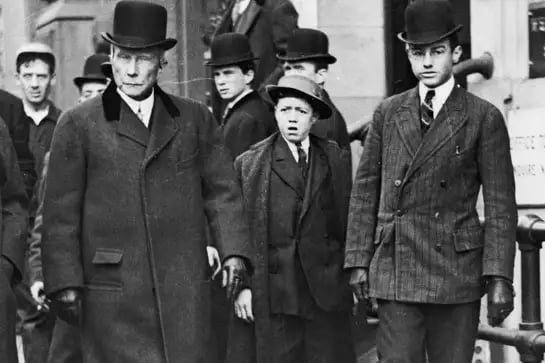
Swag.
To crush his competitors, Rockefeller would create a shortage of the railroad tank cars that transported oil. He’d then buy up all the barrels on the market so his competitors would have no place to store or ship their oil. He bought up all the available chemicals that were necessary to refine oil.
Rockefeller even had Standard Oil men communicate in code. The company was nicknamed “Club”; John D. Rockefeller was referred to as “Chowder.”
He was so secretive and ruthless that few people knew what he sounded like. He walled himself off and the people who did know him recognized that he had no self doubts. Once he made up his mind that he was going to aquire your refinery, you might as well sell it, because it was going to be part of Standard Oil.
“The day of combination is here to stay,” he once declared. “Individualism has gone, never to return.”
But he was also shockingly modest.
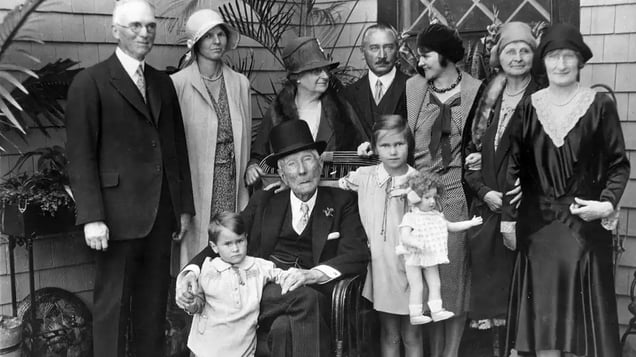
John D. and his family.
After the birth of their first child, Elizabeth, the Rockefeller clan moved to Euclid Avenue, Cleveland’s “millionaires’ row.” Rockefeller could have afforded any mansion on the street, but he deliberately picked a more modest house (with basic furnishings), where his three remaining children were born – Alta, Edith, and his only son, John Jr. Convinced that riches led to sin, Rockefeller, one of America’s richest men, faced a difficult task in raising his children.
Laura, John’s wife, made their only boy wear his sisters’ hand-me-down dresses until he was eight. She once proudly confided to a neighbor, “I am so glad my son has told me what he wants for Christmas, so now it can be denied him.”
And Rockefeller was practicing what he made his children do. He was famous for buying one suit a year, wearing it every day until it was unwearable.
And he was kind, too.
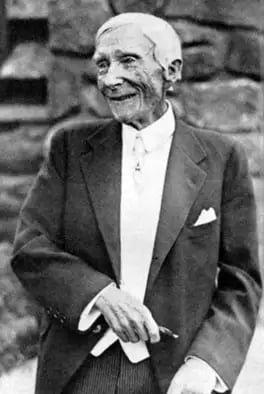
Rockefeller began to smile more later in life.
Rockefeller treated his top managers as conquering heroes and gave them praise, rest, and comfort. He’d allow executives to have their say and, at the end of the meeting, they’d vote on the right action.
He gave compliments and avoided yelling. “Very well kept—very indeed,” said Rockefeller to an accountant about his books before pointing out a minor error and leaving.
Once, a new accountant moved into a room where Rockefeller kept an exercise machine. Not knowing what Rockefeller looked like, the accountant saw him and ordered him to remove it. “All right,” said Rockefeller, and he politely took it away. Later, when the embarrassed accountant found out whom he had chided, he expected to be fired but Rockefeller never mentioned it.
Life after wealth
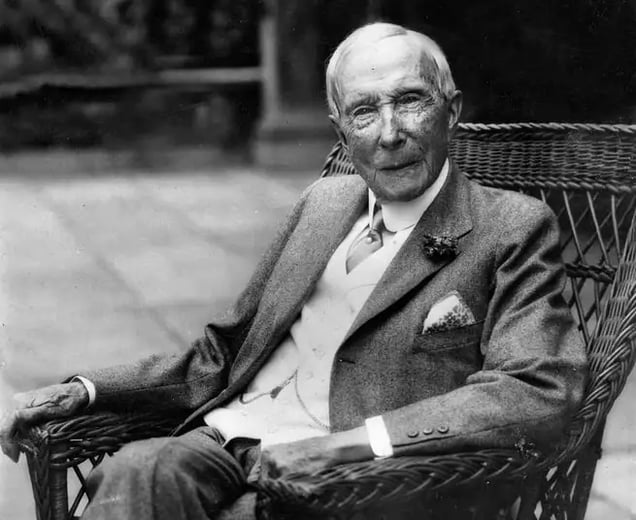
An old, more relaxed John D.
After retiring from Standard Oil in his 50s, he hired Rev. Frederick Gates, a Baptist minister, to help him forge a new set of principles for philanthropy.
Frederick Gates pushed him, warning, “Mr. Rockefeller your fortune is rolling up like an avalanche! You must distribute it faster than it grows! If you do not, it will crush you and your children and your children’s children!”
Already strained by the demands of making money, Rockefeller now staggered under the new pressures of giving it away. “I investigated and worked myself almost to a nervous breakdown,” he said, “in groping my way through the ever-widening field of philanthropic endeavor.”
In 1911, after a decade in court, the Supreme Court ordered Standard Oil to divest itself within six months.
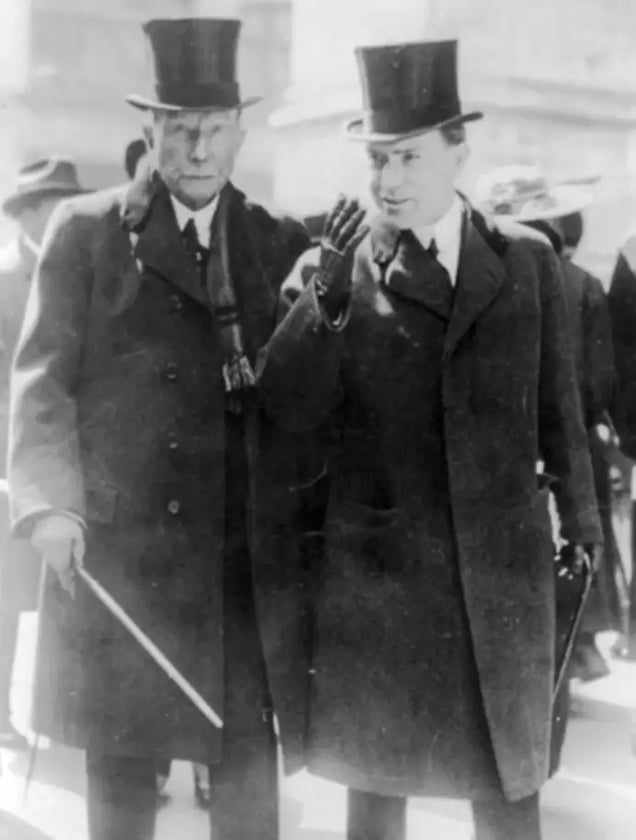
John D. Rockefeller, Sr. with his son John D., Jr. John Jr. would go on to build the famous Rockefeller Center in New York.
Known as the Sherman Antitrust Act, Standard Oil was now forced to break up.
While an unintended consequence, breaking up his monopoly actually made Rockefeller’s net worth increased significantly as each new equity piece began growing like Standard Oil did in the early days. Two years after the monopoly broke up, Rockefeller’s net worth was $900 million, more than double what Bill Gates has now when adjusted for inflation, making him the richest man ever.
At the old age of 97, Rockefeller failed to achieve his final goal.
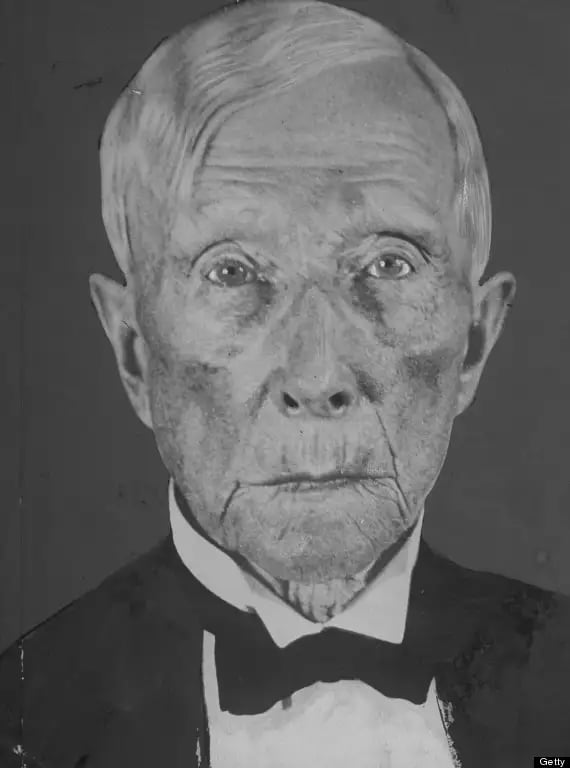
Want more on the great John D.? Make sure to pick up Titan, his biography written by the amazing Ron Chernow.

